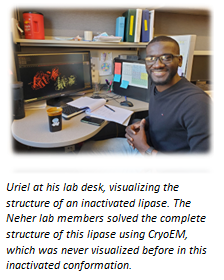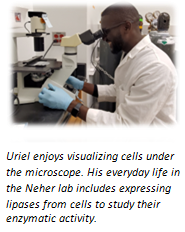Author: Dalia Fleifel, PhD student in Cook lab
 Fats are essential components in our daily intake of food. Our human body must effectively break down fats, or lipids, into smaller chunks that can be easily digested and absorbed. In our modern fast-paced world where junk foods high in fats are frequently consumed, incidence of heart and liver diseases linked with excess fat intake have increased. Scientists in the Neher lab at the University of North Carolina at Chapel Hill (UNC-CH) are experts in studying the enzymes in our body that break down lipids, which are known as lipid hydrolyzing enzymes or lipases (“lip” for lipids; “ase” for enzyme activity). Importantly, in diseases where the blood lipid levels are abnormally high, lipases are not as efficient in hydrolyzing the excess lipid particles for unknown reasons. Scientists in the Neher lab are attempting to answer critical questions such as: how are lipases regulated inside our bodies? How do they get access to the lipid particles circulating in our blood? What is special about the lipase structure that enables its function? Answering these questions will allow scientists to develop more effective therapeutics to activate lipases and help clear out excess lipids in several diseases.
Fats are essential components in our daily intake of food. Our human body must effectively break down fats, or lipids, into smaller chunks that can be easily digested and absorbed. In our modern fast-paced world where junk foods high in fats are frequently consumed, incidence of heart and liver diseases linked with excess fat intake have increased. Scientists in the Neher lab at the University of North Carolina at Chapel Hill (UNC-CH) are experts in studying the enzymes in our body that break down lipids, which are known as lipid hydrolyzing enzymes or lipases (“lip” for lipids; “ase” for enzyme activity). Importantly, in diseases where the blood lipid levels are abnormally high, lipases are not as efficient in hydrolyzing the excess lipid particles for unknown reasons. Scientists in the Neher lab are attempting to answer critical questions such as: how are lipases regulated inside our bodies? How do they get access to the lipid particles circulating in our blood? What is special about the lipase structure that enables its function? Answering these questions will allow scientists to develop more effective therapeutics to activate lipases and help clear out excess lipids in several diseases.
Uriel Jean-Baptiste is a third-year Biochemistry graduate student in the Neher lab who studies a special lipase, which is the Endothelial Lipase (EL). The EL is an enzyme that hydrolyzes lipids and facilitates their absorption into the inner, endothelial lining of our blood vessels. “I am particularly measuring the rate of the EL’s enzymatic reaction on different lipid substrates and trying to visualize its 3D structure using CryoEM” explains Uriel. “I am also exploring how the EL’s endogenous inhibitors prevent its lipase activity when they are in our blood vessels” continues Uriel. Other members of the Neher lab use cutting–edge technologies such as Cryo Electron Microscopy (CryoEM) to visualize the structure of lipases at extraordinarily detailed levels.
 When asked what brought him into science, Uriel explained, “My passion for science started in middle school, particularly in an Earth science class. I started to learn about the different layers of the Earth, how the cloud and rain cycle works, how plants grow from the soil and suck water from their roots”. He realized he was interested in the structure of things in general and how their unique structures can dictate their function. He decided to study Biochemistry as an undergraduate student. In his junior year, he got involved in his first research experience where he studied the CRIPSR-Cas9 system: a gene editing tool that uses the Cas9 enzymes to edit DNA sequences. “This is when my passion and curiosity about enzymes began” adds Uriel. “I decided to pursue a PhD in Biochemistry at UNC-CH which is a top university that is well-equipped to answer the fundamental question of how lipases work on a detailed molecular level”.
When asked what brought him into science, Uriel explained, “My passion for science started in middle school, particularly in an Earth science class. I started to learn about the different layers of the Earth, how the cloud and rain cycle works, how plants grow from the soil and suck water from their roots”. He realized he was interested in the structure of things in general and how their unique structures can dictate their function. He decided to study Biochemistry as an undergraduate student. In his junior year, he got involved in his first research experience where he studied the CRIPSR-Cas9 system: a gene editing tool that uses the Cas9 enzymes to edit DNA sequences. “This is when my passion and curiosity about enzymes began” adds Uriel. “I decided to pursue a PhD in Biochemistry at UNC-CH which is a top university that is well-equipped to answer the fundamental question of how lipases work on a detailed molecular level”.
How do you feel being part of the scientific community?
“I feel honored and humble. Every day I get to discover new things in Biology that no one knew about, share it with the scientific community and add a new piece to the human body puzzle” Uriel.
